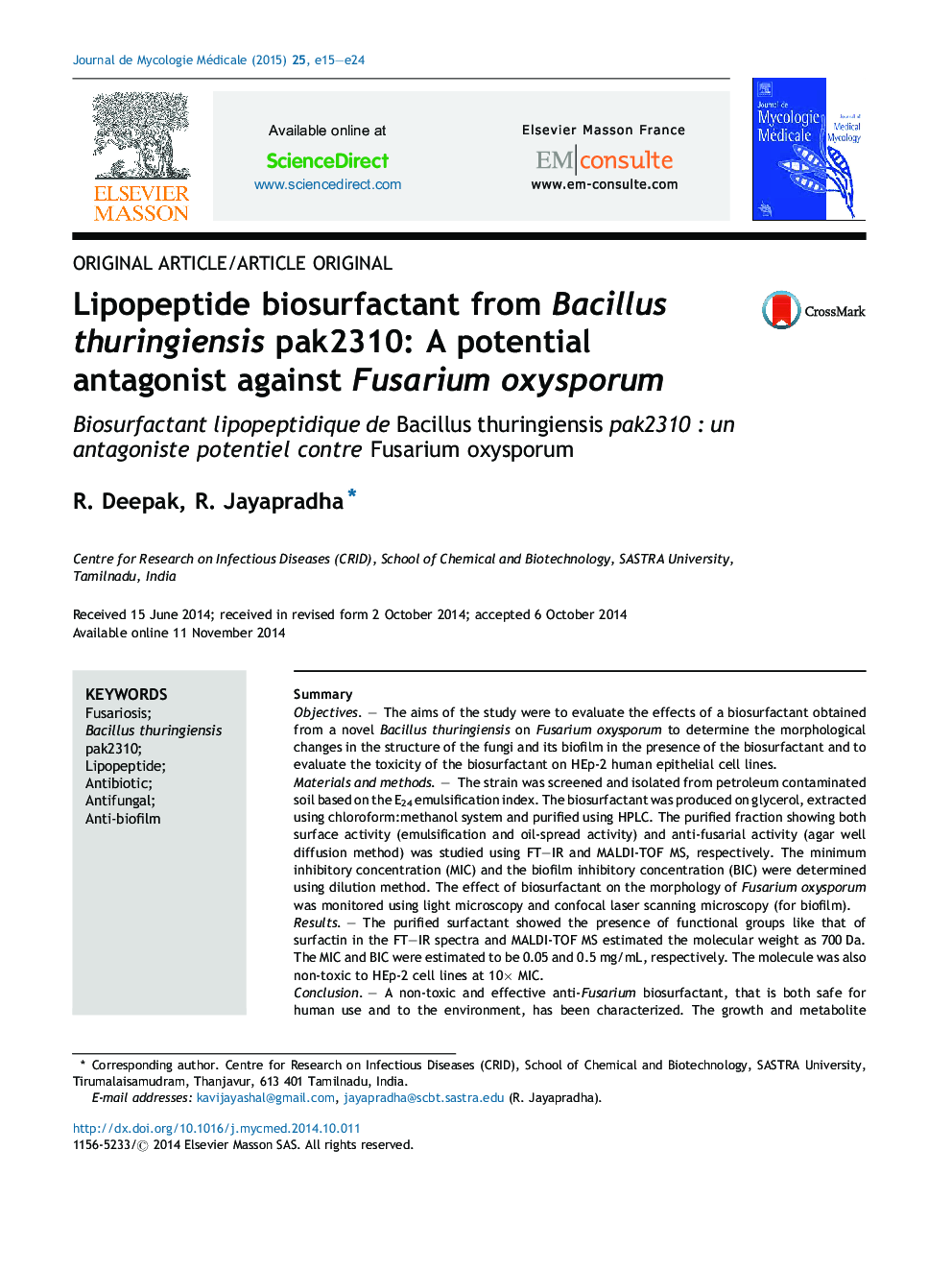| کد مقاله | کد نشریه | سال انتشار | مقاله انگلیسی | نسخه تمام متن |
|---|---|---|---|---|
| 3219762 | 1204453 | 2015 | 10 صفحه PDF | دانلود رایگان |

SummaryObjectivesThe aims of the study were to evaluate the effects of a biosurfactant obtained from a novel Bacillus thuringiensis on Fusarium oxysporum to determine the morphological changes in the structure of the fungi and its biofilm in the presence of the biosurfactant and to evaluate the toxicity of the biosurfactant on HEp-2 human epithelial cell lines.Materials and methodsThe strain was screened and isolated from petroleum contaminated soil based on the E24 emulsification index. The biosurfactant was produced on glycerol, extracted using chloroform:methanol system and purified using HPLC. The purified fraction showing both surface activity (emulsification and oil-spread activity) and anti-fusarial activity (agar well diffusion method) was studied using FT–IR and MALDI-TOF MS, respectively. The minimum inhibitory concentration (MIC) and the biofilm inhibitory concentration (BIC) were determined using dilution method. The effect of biosurfactant on the morphology of Fusarium oxysporum was monitored using light microscopy and confocal laser scanning microscopy (for biofilm).ResultsThe purified surfactant showed the presence of functional groups like that of surfactin in the FT–IR spectra and MALDI-TOF MS estimated the molecular weight as 700 Da. The MIC and BIC were estimated to be 0.05 and 0.5 mg/mL, respectively. The molecule was also non-toxic to HEp-2 cell lines at 10× MIC.ConclusionA non-toxic and effective anti-Fusarium biosurfactant, that is both safe for human use and to the environment, has been characterized. The growth and metabolite production using glycerol (major byproduct of biodiesel and soap industries) also adds up to the efficiency and ecofriendly nature of this biosurfactant.
RésuméObjectifsLes objectifs de cette étude étaient d’évaluer les effets d’un bio-tensioactif obtenu à partir d’un Bacillus thuringiensis nouveau, sur Fusarium oxysporum, afin de déterminer les changements morphologiques dans la structure du champignon et de son biofilm en présence de l’agent bio-tensioactif et d’évaluer la toxicité du biosurfactant sur des lignées de cellules épithéliales humaines HEp-2.Matériels et méthodesLa souche a été criblée et isolée à partir de sols contaminés par du pétrole sur la base de l’indice de mise en émulsion E24. Le bio-tensioactif a été produit sur le glycérol, extrait à l’aide de chloroforme:methanol système et purifié en utilisant une HPLC. La fraction purifiée montrant à la fois une activité de surface (émulsification et l’activité de propagation de l’huile) et de l’activité anti-Fusarium (méthode de diffusion en gélose par puits) a été étudiée à l’aide de FT–IR et MALDI-TOF MS, respectivement. La concentration minimale inhibitrice (CMI) et la concentration inhibitrice biofilm (BIC) ont été déterminées en utilisant la méthode de dilution. L’effet du biosurfactant sur la morphologie de Fusarium oxysporum a été objectivée en utilisant la microscopie optique confocale à balayage laser et la microscopie du biofilm.RésultatsL’agent tensioactif purifié a montré la présence de groupes fonctionnels, tels que des surfactines dans les spectres FT–IR et MALDI-TOF MS avec un poids moléculaire estimé à 700 Da. La CIM et BIC ont été estimées à 0,05 et 0,5 mg/mL, respectivement. La molécule était également non toxique pour les cellules HEp-2 dans des lignées de cellules 10× MIC.ConclusionUn biosurfactant anti-Fusarium non toxique et efficace, à la fois sans danger pour la consommation humaine et l’environnement a été caractérisé. La croissance et la production de métabolites en utilisant du glycérol (sous-produit majeur de biodiesel et de savon d’industrie) ajoute également à l’efficacité écologique et à la protection de la nature de ce biosurfactant.
Journal: Journal de Mycologie Médicale / Journal of Medical Mycology - Volume 25, Issue 1, March 2015, Pages e15–e24